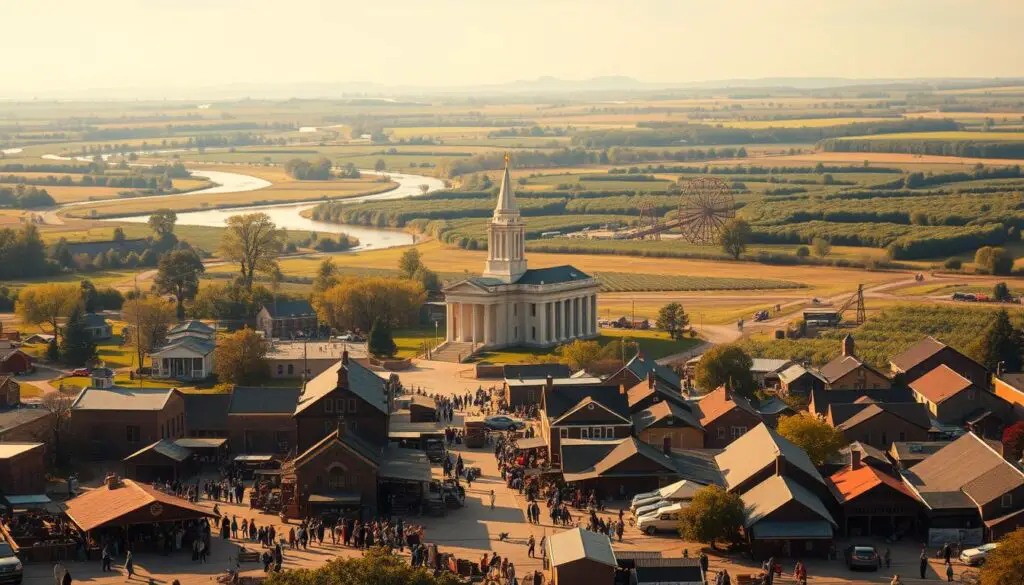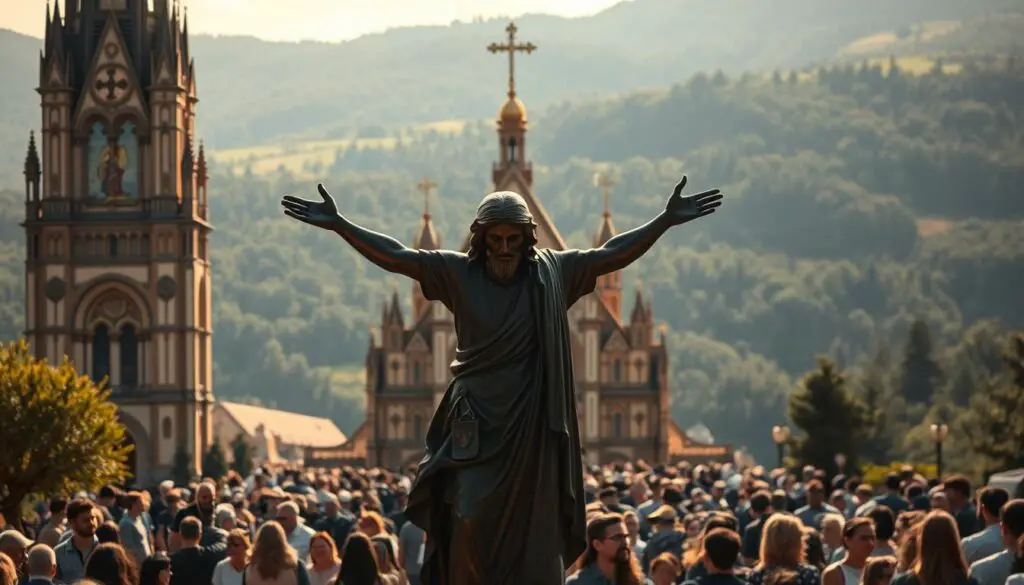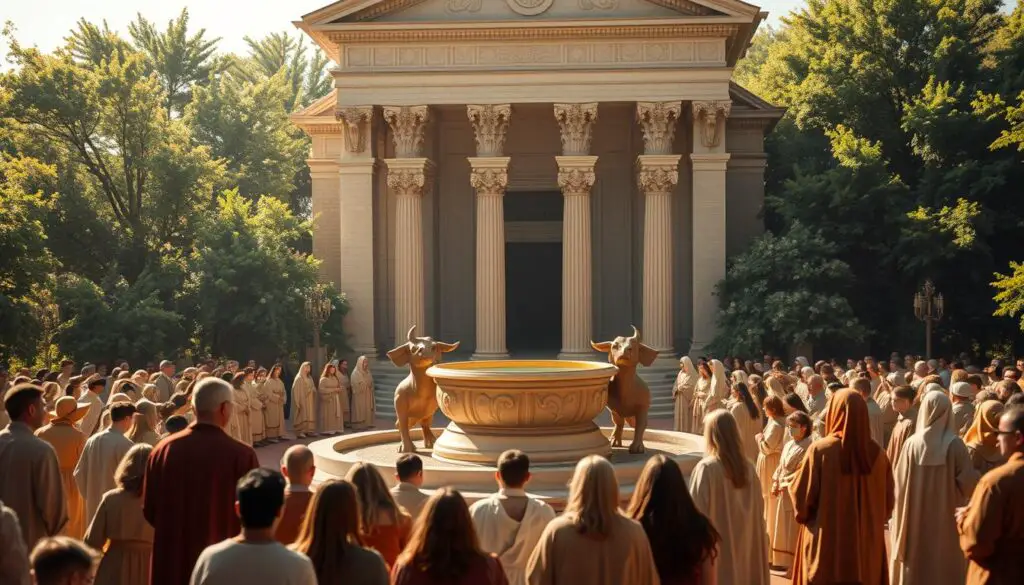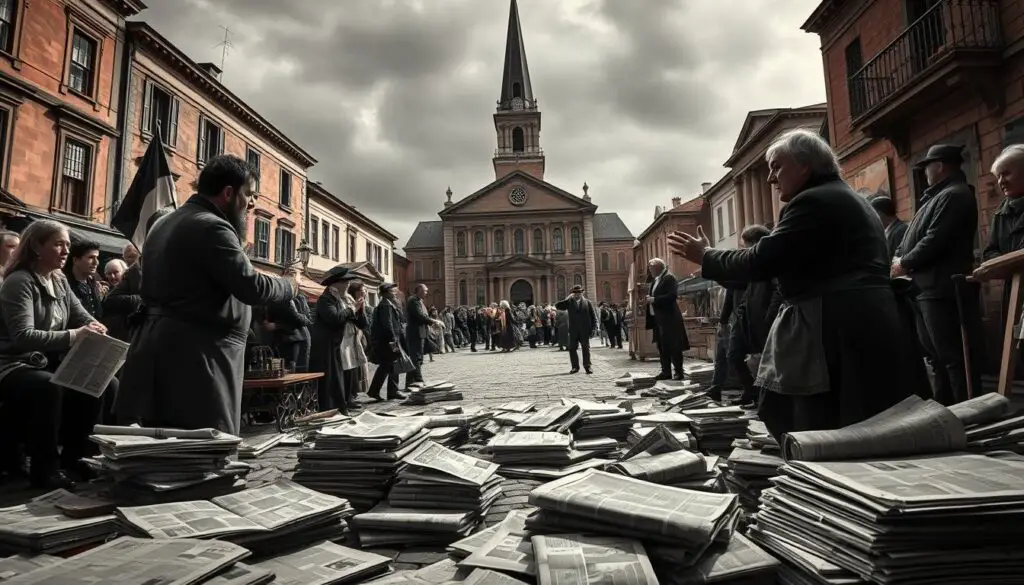Step into a story where early Native American settlements blossomed into a thriving 19th-century hub. Nestled along the Mississippi River, this city became a cornerstone of faith, resilience, and cultural exchange. Its name, meaning “they are beautiful,” was chosen by Joseph Smith in 1840, reflecting its natural charm and spiritual significance.
Once among Illinois’ largest urban centers, the area thrived through trade and community-building long before its religious prominence. The blend of Indigenous traditions, pioneer grit, and visionary leadership shaped its unique identity. Today, visitors explore preserved streetscapes and landmarks that whisper tales of ambition and perseverance.
At the heart of this heritage stands the iconic temple, a symbol of devotion rebuilt to honor its original design. The city’s role in shaping religious movements across the United States remains undeniable. Yet, its appeal extends beyond history buffs—think riverside strolls, artisan shops, and festivals celebrating its layered past.
Ready to dig deeper? Let’s journey through time to discover how this remarkable place became a beacon of hope and renewal.
Key Takeaways
- Originally named by Joseph Smith, the city’s title translates to “they are beautiful.”
- It grew rapidly in the 1840s, becoming one of Illinois’ largest urban areas.
- The rebuilt temple serves as a central landmark honoring its spiritual legacy.
- Rich Native American and pioneer influences shaped its cultural foundation.
- Modern visitors enjoy historical sites alongside scenic river views.
Origins and Early Settlement of Nauvoo
Centuries before becoming a religious epicenter, this stretch of land along the Mississippi River buzzed with Indigenous life. The Sauk and Meskwaki tribes cultivated a vibrant village here, drawn to the river’s fertile banks and strategic trade routes.
Sauk and Meskwaki Heritage
For generations, the Sauk called the area Quashquame, named after a respected leader. Their community thrived through fishing, farming, and trading with neighboring tribes. The Meskwaki later joined them, creating a shared place of cultural exchange.
| Aspect | Sauk & Meskwaki | Early Europeans |
|---|---|---|
| Settlement Name | Quashquame | Venus/Commerce |
| Economic Focus | Hunting, Trade | Agriculture, Trade |
| Key Feature | River Access | Town Planning |
From Quashquame to Venus
In 1824, Captain James White purchased the land from Quashquame’s descendants. Settlers renamed it Venus, dreaming of a bustling port town. Though malaria slowed growth, the people persisted—rebranding the area as Commerce in 1834 to attract investors.
Located in Hancock County, the site’s riverside position made it ideal for trade. By 1839, this evolving place stood ready for its next chapter—one that would reshape American religious history.
The Transformation: Commerce to Nauvoo
In 1839, a struggling riverside town got a second chance. Investors had renamed it Commerce three years earlier, but malaria and financial woes kept progress stagnant. That changed when a determined group purchased the land, setting the stage for Illinois’ most ambitious urban experiment.

Within two years, the population exploded from a few hundred to over 3,000. The state legislature approved a groundbreaking city charter in 1840, granting unprecedented self-governance powers. This legal framework let leaders create courts, a militia, and tailored tax policies—tools that fueled rapid growth.
| Aspect | Commerce (1834-1839) | Post-1840 Era |
|---|---|---|
| Population | ~200 residents | 12,000+ by 1844 |
| Economy | Limited trade | Brickworks, mills, shipbuilding |
| Governance | County oversight | Independent city council |
| Timeframe | 5 stagnant years | 4-year boom |
The timing proved perfect. As eastern cities faced overcrowding, this Mississippi River location offered space and opportunity. Civic planners designed wide streets and public squares, blending practicality with grandeur. By 1844, it rivaled Chicago in size and ambition.
Local government innovations under the charter attracted skilled workers and businesses. What began as a rebranding effort became a case study in how legal flexibility and community vision can reshape a region’s destiny.
Joseph Smith and the Founding of a City
Visionary leaders often leave lasting marks on the places they shape. When religious settlers arrived in 1839, they found a swampy riverside town called Commerce. Within months, Joseph Smith transformed it into a thriving spiritual hub through bold ideas and infectious optimism.
Charismatic Leadership and Vision
Joseph Smith didn’t just rename the area—he reimagined it. Inspired by Hebrew language, he chose “Nauvoo” (“they are beautiful”) to reflect both natural beauty and community ideals. His city plans featured wide streets, public squares, and over 2,500 lots for homes and businesses.
Collaboration fueled progress. Early leaders like Brigham Young helped organize construction projects and social programs. Together, they created neighborhoods with schools, workshops, and cultural spaces. This teamwork turned swampy land into a model community buzzing with civic pride.
The Meaning Behind the Name “Nauvoo”
The name’s poetic meaning went beyond scenery. It symbolized hope for a society where people lived harmoniously, guided by shared values. Streets named after virtues like Peace and Wisdom reinforced this vision daily.
By 1844, the city’s population neared 12,000—a testament to Smith’s ability to inspire collective action. His blend of practical planning and spiritual purpose made Nauvoo a blueprint for utopian communities nationwide.
Building a Theocratic Community
Imagine living in a place where Sunday sermons shaped Monday’s laws. For the Church of Jesus Christ, faith wasn’t just a belief—it was the blueprint for daily life. Civic duties and spiritual practices blended seamlessly, creating a society where religious leaders also managed schools, courts, and welfare programs.

The Latter-day Saints built more than houses—they crafted a shared identity. Families joined neighborhood groups that met weekly to discuss crops, childcare, and scripture. These circles fostered trust, turning strangers into extended kin. As one settler wrote, “We didn’t just share bread; we carried each other’s burdens.”
Safety was a team effort. Men formed night watches to patrol streets, while women organized charity networks for the sick. This focus on protection wasn’t about walls—it grew from close-knit bonds. When conflicts arose with outsiders, the community leaned on its unity as both shield and compass.
Key features of their system included:
- A city council led by Church of Jesus Christ authorities
- Volunteer labor crews maintaining public spaces
- Cultural events blending worship with civic pride
Through these efforts, the Latter-day Saints proved that shared purpose could turn swampland into solidarity. Their experiment showed how faith could shape not just hearts, but entire neighborhoods.
Nauvoo City Charter and Early Governance
In 1840, a bold legal document reshaped the Mississippi River’s edge into a laboratory for civic innovation. The Nauvoo charter, crafted with help from lawyer John C. Bennett, granted sweeping powers rarely seen in frontier towns. It allowed the city council to form courts, regulate commerce, and even maintain an independent militia—a level of self-rule that caught the governor’s attention.
City Planning and the Plat of Zion
Urban design here wasn’t just practical—it was prophetic. Inspired by the “Plat of Zion” concept, streets stretched 132 feet wide to foster community gatherings. Blocks held space for schools, parks, and temples, blending spiritual ideals with civic needs. As one settler noted, “We built not just houses, but the blueprint for heaven on earth.”
Establishing Municipal Institutions
The city council moved fast to create order. Within months, they’d launched:
- A court system resolving disputes without state oversight
- Tax policies funding roads and public safety
- Building codes requiring fire-resistant brick homes
| Institution | Role | Impact |
|---|---|---|
| Nauvoo Legion | Local militia | Defense & civic pride |
| City Council | Lawmaking | Swift local decisions |
| Mayor’s Court | Dispute resolution | Reduced outside interference |
This bold government model drew both admiration and suspicion. While it fueled rapid growth, the charter’s unique freedoms planted seeds for later clashes. The experiment proved that self-rule could build a thriving community—but also challenge the status quo.
Religious Innovations and Practices
Spiritual revolutions often leave lasting imprints—and the 1840s here buzzed with groundbreaking ideas. At the heart of this transformation stood teachings that redefined connections between the living, the divine, and ancestors. Joseph Smith introduced rituals like baptism for the dead, allowing members to honor departed loved ones through proxy ceremonies.

The temple became more than a building—it was a sacred stage for the Nauvoo endowment. This ceremony, emphasizing covenants with Jesus Christ, offered followers symbolic guidance for earthly and eternal life. As one journal entry notes, “We felt armed with heavenly knowledge to face any trial.”
| Practice | Description | Community Impact |
|---|---|---|
| Baptism for the Dead | Proxy rituals for ancestors | Strengthened family bonds |
| Endowment Ceremonies | Symbolic teachings & covenants | Deepened spiritual unity |
| Temple Worship | Centralized sacred rituals | Fostered distinct identity |
Brother Hyrum Smith played a key role in refining these practices. His leadership helped turn theological concepts into shared traditions. The emphasis on direct relationships with Jesus Christ set these teachings apart from mainstream Christianity of the era.
Though controversial then, these innovations created a tight-knit community. Families gathered weekly to discuss temple preparations, blending daily life with spiritual purpose. Their unique approach became both a unifying force and a marker of difference—a dual legacy that still echoes today.
Growing Conflict and Community Tensions
Unity often masks underlying fractures. By 1844, rapid growth strained relationships within the once-cohesive settlement. Differences in political views and leadership approaches created invisible fault lines.

Internal Disagreements and Political Power
Dissent grew as some residents questioned centralized authority. A faction argued for more secular governance, clashing with religious leaders over decision-making power. These debates spilled into public spaces, turning neighbor against neighbor.
The newspaper industry became a battleground. Critics launched the Nauvoo Expositor in June 1844, publishing exposes on controversial practices. Local leaders swiftly condemned it as libelous, ordering the press destroyed. This drastic move polarized opinions further.
| Faction | Goals | Methods |
|---|---|---|
| Reformers | Transparency & checks on power | Publishing critiques |
| Leadership | Maintain unity & vision | Legal enforcement |
| Neutrals | Peaceful coexistence | Mediation attempts |
Violence erupted as tensions boiled over. Mobs targeted critics, while state officials like Governor Thomas Ford struggled to mediate. Threats and arrests became common tools in this ideological war.
The shadow of death loomed as rhetoric intensified. What began as policy disputes now threatened lives. These clashes set the stage for the community’s most dramatic chapter—one where survival would hinge on difficult choices.
Destruction of the Nauvoo Expositor and Escalating Strife
A single act of defiance sparked a chain reaction that reshaped the community’s future. In June 1844, the city council declared the Nauvoo Expositor a public nuisance. The newspaper had criticized leadership practices, prompting officials to order its printing press destroyed. Workers smashed the machine and burned remaining copies in the street.
The decision divided residents instantly. Supporters saw it as protecting unity, while critics called it censorship. “A free press matters,” wrote one dissenter, “even when truths sting.” Neighbors who once shared meals now avoided eye contact.
Outsiders seized on the press incident as proof of tyranny. Mobs gathered, demanding arrests. The state militia mobilized, and leaders faced warrants. Tensions reached a boiling point when Joseph Smith and his brother Hyrum surrendered to authorities. Their transfer to Carthage jail aimed to calm tensions—but had the opposite effect.
On June 27, 1844, an armed crowd stormed the jail. Both brothers died in the attack, marking a tragic turn. This death toll deepened divisions, making peaceful compromise impossible.
The fallout fractured families and friendships. Even siblings found themselves on opposing sides of the conflict. What began as a local dispute became a cautionary tale about power, dissent, and the cost of escalation.
The Mormon Exodus: Glory, Conflict, and New Beginnings
Frostbitten fields stretched silent as families packed wagons by lantern light in February 1846. The death of Joseph Smith and his brother Hyrum two years earlier had left a leadership void—and rising hostility made staying impossible. A communal vote confirmed the painful choice: abandon homes for an uncertain future west.
Preparation and Departure
Leaving meant heartbreak and ingenuity. Some sold properties at losses; others buried heirlooms they couldn’t carry. “We kissed our doors goodbye,” wrote one diarist. Harsh winter weather tested resolve as people converted wagons into floating homes using Mississippi River ice.
Brigham Young’s organized timeline kept chaos at bay. Crews built waystations ahead, while scouts mapped routes. Despite careful plans, disease and exhaustion claimed lives. The death of Joseph Smith lingered in collective memory, fueling both grief and determination.
The Journey Westward
By spring, thousands trundled across Iowa’s mud-choked plains. Wagons bore slogans like “Zion Bound”, blending hope with defiance. A second vote at key crossroads reinforced unity when dissent threatened progress.
Time became both enemy and ally. Delays risked food shortages, yet nightly campfires forged deeper bonds. As the column snaked toward the Rockies, this fractured community began rewriting its story—one dusty mile at a time.
Rebirth of Nauvoo as a Historic Destination
Preservation efforts have turned this riverside gem into a vibrant window to the 19th century. Organizations like Nauvoo Restoration, Inc. and the Church of Jesus Christ of Latter-day Saints spearheaded campaigns to revive over 30 historic sites. Their work transformed crumbling structures into time capsules where visitors touch the past.
Restoration Efforts and Preservation
Local citizens played starring roles in safeguarding their heritage. Volunteers cataloged artifacts while craftsmen mastered period techniques to repair historic homes and wooden trim. “We didn’t just rebuild walls,” shares a longtime resident, “we rekindled stories.”
Today’s walking tours showcase this meticulous work. Guests explore restored residences, workshops, and the iconic temple—each space filled with original furnishings. Interactive exhibits let travelers churn butter or dip candles, making history feel alive.
The city’s rebirth as a cultural destination proves that even places marked by conflict can become bridges to understanding. Annual festivals and living history programs continue this legacy, inviting all to connect with America’s layered past.
Exploring the Legacy of mormon nauvoo
A city’s spirit endures long after its founders have passed. The stories of resilience and shared purpose here continue to shape Hancock County’s identity. Every man, woman, and child played a part in weaving this tapestry—from brickmakers to teachers, their efforts echo through time.
Though the 1846 exodus seemed like an end, it sparked new beginnings. Settlers carried traditions westward while leaving behind a blueprint for communal living. Today, preserved workshops and festivals honor their ingenuity, proving that legacies evolve rather than fade.
| Aspect | 19th Century | Modern Influence |
|---|---|---|
| Community Values | Collective labor & faith | Cultural preservation efforts |
| Economic Impact | River trade & crafts | Tourism & education |
| Architectural Legacy | Brick homes & wide streets | Restored landmarks |
Hancock County’s museums and oral histories keep this era alive. Neighboring towns adopted agricultural techniques pioneered here, while interfaith dialogues trace roots to early cooperation. As one historian notes, “Their greatest achievement wasn’t a city—it was showing how ordinary people build extraordinary futures.”
Ready to walk where visionaries once stood? Each cobblestone and riverside vista invites you to add your chapter to this unfolding story.
Conclusion
From its roots as a Native American riverside village to a bustling 19th-century hub, this city’s story weaves faith, conflict, and renewal. Visionaries like Joseph Smith and Brigham Young transformed swampland into a thriving community guided by devotion to Jesus Christ. Their blueprint—wide streets, shared labor, and temple-centered life—shaped a unique experiment in unity.
Though marked by the death of leaders and clashes over press freedoms, the people’s resilience endured. The exodus west became a testament to collective grit, while preservation efforts later revived temple landmarks and artisan traditions. Today, restored brick homes and riverside vistas honor those who built—and rebuilt—this legacy.
Every corner here whispers tales of sacrifice and hope. Whether tracing pioneer footsteps or reflecting on the Latter-day Saints’ impact, visitors connect with America’s complex past. The city stands not as a relic, but a living classroom where history’s lessons inspire tomorrow’s dreamers.
Ready to walk where visionaries forged their future? Your journey through this enduring legacy starts now.
FAQ
What role did Joseph Smith play in founding Nauvoo?
Joseph Smith, leader of the Church of Jesus Christ of Latter-day Saints, transformed the swampy town of Commerce into a thriving religious hub. His vision included city planning inspired by the Plat of Zion and establishing municipal institutions under the Nauvoo Charter.
Why was the Nauvoo Expositor’s destruction significant?
The destruction of the Nauvoo Expositor press by the city council in 1844 escalated tensions. Critics viewed it as suppressing free speech, leading to Joseph and Hyrum Smith’s arrest and eventual deaths at Carthage Jail, marking a turning point in community conflicts.
How did the city’s name change reflect its purpose?
Originally called Commerce, the city was renamed “Nauvoo,” a Hebrew term meaning “beautiful place.” This reflected Joseph Smith’s vision of creating a sanctuary for religious freedom and communal growth along the Mississippi River.
What caused the Mormon exodus from Nauvoo?
After Joseph Smith’s death, violence and political pressure from Hancock County residents forced Brigham Young and other leaders to organize a westward migration. This journey eventually led to the settlement of Salt Lake City, Utah.
How is Nauvoo preserved today?
Historic sites like the Nauvoo Temple and restored homes showcase the city’s legacy. Preservation efforts by the Church of Jesus Christ of Latter-day Saints and local groups highlight its role in 19th-century religious and American frontier history.
What made Nauvoo’s governance unique?
The Nauvoo Charter granted unusual autonomy, allowing the city to form its own militia and courts. This self-governance fueled both rapid growth and external suspicion, contributing to clashes with Illinois state authorities.
How did early settlers interact with Indigenous communities?
Before Latter-day Saints arrived, the Sauk and Meskwaki tribes inhabited the region. Settlements like Quashquame’s village near the Mississippi River later gave way to Euro-American development, reshaping the area’s cultural landscape.